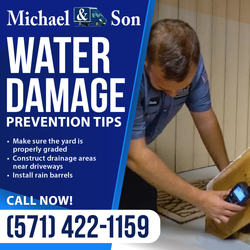How Horticulture and Irrigation Techniques Can Prevent Water Damage and Conserve Water
Michael & Son Water and Mold is committed to meeting client’s needs by providing the water damage restoration services that people need in moments of crisis. Strategies for avoiding a water damage disaster are welcome resources, especially when a homeowner has recently had to deal with a water damaged home. The team of professionals at Michael & Son Water and Mold is sharing tips on how to use horticulture and irrigation techniques to help homeowners avoid water damage and conserve water.
Horticultural Strategies for Preventing Water Damage and Conserving Water
Xeriscaping is a landscaping method that utilizes water conserving techniques such as the use of drought tolerant plants, mulch, and efficient irrigation. In xeriscaping, special care is taken to avoid losing water to evaporation and run-off. The specific plants used in xeriscaping depend upon the climate. Xeriscaping differs from natural landscaping even though the plant selection may include some of the same plants. The driving principle in xeriscaping is the selection of plants for water conservation.
The seven principles listed below are the pillars of xeriscaping:
Principle #1: Intentional landscape planning and design
Xeriscaping focuses on water conservation and the prevention of run-off. Efficient grading techniques can channel run-off water to beds or capture the water in holding ponds for later use. Because native plants usually require less water, they are foundational to a water-conserving planting plan.
Principle #2: Limited lawn areas
Lawn areas are limited to appropriate, functional spaces. Grass can also be planted in low areas to avoid soil erosion and to hold the water in place. Preventing the water from pooling at the foundation of the home can prevent flooding in the crawl space and basement.
Principle #3: Water efficient plant selection
These plants may be dwarf versions of more familiar varieties. Plants that have broader or deeper root systems can withstand longer periods of dryness. Some plants store onboard water in tubers. The root systems sustain the plants in periods of drought while also holding the soil in place during a heavy downpour.
Principle #4: Efficient irrigation strategies
Efficient irrigation methods reduce evaporation, run-off, and overwatering. Drip irrigation concealed under mulch targets specific plants while the mulch discourages evaporation and run-off. Timers ensure that the water is delivered at optimal times and in prescribed amounts. Moisture sensors can be deployed to communicate with the irrigation system in order to prevent waste while providing consistent and adequate saturation. Smart irrigation prevents overwatering, which can cause flooding and microbial growth issues around the foundation of a home.
Principle #5: Soil amendments that increase water retention
New water retention technologies have been developed that, when added to soil or potting mix, capture and store water until it can be used by nearby plants. One technique is to till rotted sawdust into bedding material so that the soil is enriched and retains more water.
Principle #6: Copious mulching
Mulching, as mentioned above, retains moisture and prevents water run-off and erosion while slowing down evaporation. The many different textures and colors of mulch can add interest to any landscape. Be sure to keep the mulch at least six inches below the siding of the home to prevent water intrusion, wood rot, and microbial growth.
Principle #7: Appropriate landscape maintenance
Keeping trees, bushes, shrubs, and plants trimmed and pruned reduces the demand for water. Removing weeds and unwanted vegetation from beds eliminates unnecessary competition for a limited amount of water. Refreshing mulch beds enhances water retention while inhibiting evaporation. Clean bed edges with well-defined trenches more effectively capture run-off water and channel it where it is needed.
Other Water Damage Prevention Tips
Listed below are three more strategies for preventing water damage through the use of landscaping techniques.
Tip #1: Make sure the yard is properly graded.
Prevent water from pooling next to the home’s foundation by correcting any grading issues that allow pooling. The grade should slope one inch per foot away from the foundation for at least six feet to ten feet. Keep gutters and downspouts cleaned out and maintained at all times.
Tip #2: Construct drainage areas near driveways.
Typical paved driveways can flood the garage and foundation of the home during heavy rains. Landscape solutions include the installation of a gravel driveway or a paved driveway designed to divert water. A more economical solution is to add drainage next to the driveway. Pavers or channel drains may take care of any problems.
Tip #3: Install rain barrels.
Place rain barrels at the bottom of downspouts to collect rainwater. The barrels are available in aesthetically attractive models and provide an eco-friendly way to water the vegetable garden.
When a water damage disaster strikes, Michael & Son’s certified restoration and water removal technicians are available to provide 24/7 emergency service.
Michael & Son Water and Mold works directly with the insurance company. Services include fire and smoke restoration, water extraction and flood restoration, sewage cleanup, mold remediation, and crawlspace encapsulation. For more information about water damage restoration in Hyattsville, contact Michael & Son Water and Mold by phone at (240) 244-9963.
This blog was written on Jul 30, 2021. Any pricing information is subject to change.


